This page contains the AQA GCSE Physics P3 Energy Resources Questions and kerboodle answers for revision and understanding .This page also contains the link to the notes and video for the revision of this topic.
P 3.1 Energy Demands AQA GCSE Physics P3 Energy Resources Kerboodle Answers : Page No. 37
1 a i Fossil fuel power station uses coal, oil and natural gas and hence release carbon dioxide in the atmosphere.
ii Nuclear power station uses nuclear energy and operates without fossil fuels therefore it does not release carbon dioxide in the atmosphere.
b Although Nuclear fuel releases about 10,000 times as much energy as the same mass of fossil fuels but Nuclear fuels require far more complicated systems to extract their energy, which calls for greater regulation and furthermore the waste products are radioactive.
2 a i The generation of electricity through nuclear energy reduces the amount of energy generated from fossil fuels (coal and oil). Less use of fossil fuels means lowering greenhouse gas emissions (CO2 and others). Main disadvantages is the difficulty in the management of nuclear waste.
ii Natural gas produces less carbon dioxide per unit energy than coal does, making it appear at first glance as a cleaner fuel. But natural gas is predominantly composed of methane, a much more potent greenhouse gas than carbon dioxide, and it is thought that leaks at drilling fields could outweigh its potential benefit.
b Nuclear fuel releases about 10,000 times as much energy as the same mass of fossil fuels so to produce the same amount of energy with 1 Kg of uranium fuel we require 10000Kg of fossil fuel.
3 a Ethanol is produced by fermentation of sugar which is produced from plants source therefore it is considered as A biofuel as its source is renewable.
b Carbon neutral means that the process of burning gives the same amount of carbon dioxide that was used by the source in growing. Ethanol is produced from renewable energy sources such as fermented sugar cane. The plant source while burning as a fuel released the same amount of carbon dioxide they have used while growing. Such fuels are potentially carbon-neutral because they do not result in a net increase in atmospheric greenhouse gases.
4 Energy used per year by one person = 5 X 10^20/6 X 10^9
= 8.3X10^10 J / years
1 years = 3.15 X 10^7 seconds
= 8.3X10^10 J/3.15 X 10^7 J/second
=2635 J/second
0.833*1011joules/sec
P 3.2 Energy from Wind and Water AQA GCSE Physics P3 Energy Resources Kerboodle Answers : Page No. 39
1 a Renewable Energy resources are the resources like hydroelectricity, tidal power and wind power, which can be used again and again and will never run out.
b i Hydroelectricity is the renewable source that does not need energy from the sun.
ii Wind power is the renewable source that does not need water and is unreliable.
- a i 1000 wind turbine would give the same total output as a tidal power station .
ii 500/20=25kilometers of wave generators will give the same total output as a hydroelectric power station.
2 a Cost per MW of a tidal power station is much higher than that of a hydroelectric power station because it needs more construction for their power station as compare to hydroelectric power station. Tidal power or tidal energy is a form of hydropower that converts the energy obtained from tides into useful forms of power, mainly electricity.
b i energy resource that has the lowest total cost per MW is Hydroelectric energy.
ii Resource might be unsuitable in many locations because adequate amount of water, wind or tides required for generating electricity in power stations.
4 a Pumped-storage hydroelectricity (PSH), or pumped hydroelectric energy storage (PHES), is a type of hydroelectric energy storage used by electric power systems for load balancing. … During periods of high electrical demand, the stored water is released through turbines to produce electric power.
b Benefit to electricity users of a pumped storage scheme are as such:
These are unique among all the hydroelectric power plants as no flowing water supply is required. Once the head or trail pond is filled, then only inflow required is to compensate for the evaporation and separate losses.
P 3.3 Power from the Sun and the Earth AQA GCSE Physics P3 Energy Resources Kerboodle Answers : Page No. 41
1 a The source of geothermal energy are radioactive substances deep within the Earth.
b Geothermal energy is more reliable than solar energy for heating water because it helps to reduce greenhouse gas emissions because of the technologies used in the system of heating.
2 a Number of cells in the panel are = 300/0.2 = 1500.
b Satellite carries batteries that are charged by electricity from the solar cell panels because in absence of sunlight we can use batteries.
3 a Kilowatt-hours of energy the power station generates in 24 hours
P = Wt (Power = Work[Energy] x time)
Convert Watts to Kilowatts (W -> kW)
2,000,000W -> 2,000kW [divide by 1000]
Multiply work by time (remembering the question asks for kWh)
2,000kW x 12h = 24,000 kWh
b One advantage is that energy produced from radioactive source so no requirement of wind and one disadvantage of a geothermal power station compared with a wind turbine is it cause many harmful effect to humans from radioactivity as compare to wind turbine.
4 a The energy per second transferred by the hot water from the solar panel calculated as follows:
we know that
Q = mc ΔT
Q = 0.010*4200*21 = 882J
b The output temperature of the hot water if the flow rate is reduced to 0.007 kg/s when the specific heat capacity of water is 4200J/kg”C is Q = mc ΔT
ΔT = 882/0.007*4200 = 30 degree celcius
P 3.4 Energy and the Environment AQA GCSE Physics P3 Energy Resources Kerboodle Answers : Page No. 43
1 a Fuel that is used to generate most of Britain’s electricity is Tidal power.
b Problems caused by burning fossil fuel are Global warming and acid rain.
c Advantages of using renewable energy sources instead of fossil fuels
1 It has low or zero carbon and greenhouse emission.
2 They emit zero toxic gases in atmosphere such as carbon dioxide and sulfur dioxide which cause acid rain.
Disadvantages of using renewable energy sources instead of fossil fuels
1 The electricity generation capacity is still not large enough.
2 it can be reliable depends on weather.
2 a-B,b-D,c-C,d-A.
3 a Possible renewable energy resources that could be used to generate electricity for people on a remote flat island in a hot climate are Solar, wind, geothermal
b Types of power stations that do not release greenhouse gases into the atmosphere are Solar, wind and geothermal
4 A nuclear power station can each supply enough power to meet the electricity needs of a large city on an estuary
Advantages:-
No greenhouse gases (unlike fossil fuel),
Much more energy is transferred from each kilogram of uranium (or plutonium) fuel than from fossil fuel.
Disadvantages :-
Used fuel rods contain radioactive waste, which has to be stored safely for centuries.
Nuclear reactors are safe in normal operation. However, an explosion in 3 reactor could release radioactive material over a wide area. This would affect this area, and the people living there, for many years.
A Tidal power station can each supply enough power to meet the electricity needs of a large city on an estuary
Advantages:-
1) It is an inexhaustible source of energy.
2) Tidal energy is environment friendly energy and doesn’t produce
greenhouse gases.
Disadvantages:-
1) Cost of construction of tidal power plant is high.
2) There are very few ideal locations for construction of plant and they too are localized to coastal regions only.
Wind turbines
Advantages:-
Renewable & Sustainable.
Environmentally Friendly.
Disadvantages:-
The Wind Fluctuates.
Installation is Expensive.
Banner 1
Banner 2
P 3.5 Big Energy Issues AQA GCSE Physics P3 Energy Resources Kerboodle Answers : Page No. 45
1 a The power station that can be started fastest is Oil-fired and gas-fired power station.
b Power station that does not produce greenhouse gases or radioactive waste is solar power station.
c Renewable resource of energy that are unreliable are solar and wind.
d Renewable resource that can be used to store energy at times of low electricity demand is Solar energy resource.
2 if people use renewable energy then no global warming and acid rain occurs.
b if people use only nuclear energy then no global warming and acid rain
3 Nuclear power stations are unsuitable for meeting daily variations in the demand for electricity because due to nuclear waste and produce less amount of electricity and also abundance of uranium.
4 Pumped storage schemes are useful because pumped-storage hydroelectricity (PSH), or pumped hydroelectric energy storage (PHES), is a type of hydroelectric energy storage used by electric power systems for load balancing. The method stores energy in the form of gravitational potential energy of water, pumped from a lower elevation reservoir to a higher elevation. Low-cost surplus off-peak electric power is typically used to run the pumps. During periods of high electrical demand, the stored water is released through turbines to produce electric power. Although the losses of the pumping process
makes the plant a net consumer of energy overall, the system increases revenue by selling more electricity during periods of peak demand, when electricity prices are highest.
5 a The resource that has the lowest capital costs is hydroelectricity.
b i Hydroelectricity has the lowest overall costs than wind and solar power because the hydro station consumes no water. With a dam and reservoir it is also a flexible source of electricity since the amount produced by the station can be changed up or down very quickly to adapt to changing energy demands. Once a hydroelectric complex is constructed, the project produces no direct waste.
ii Hydroelectricity has the lowest overall costs than non-renewable sources because The hydro station consumes no water, unlike coal or gas plants.With a dam and reservoir it is also a flexible source of electricity since the amount produced by the station can be changed up or down very quickly to adapt to changing energy demands.
Once a hydroelectric complex is constructed, the project produces no direct waste, and has a considerably lower output level of greenhouse gases than fossil fuel powered energy plants.
Banner 1
AQA GCSE Physics P3 Energy ResourcesSummary questions: Kerboodle Answer Page No. 46
1 a i Renewable energy source is a energy source replenished by natural processes at same rate as it is used
ii With the aid of a suitable example renewable fules are the fuels replenished by natural processes, e.g., ethanol, when sugar cane grows
b renewable fuels contribute to greenhouse gases in the atmosphere as they release CO2 if burnt, but produced from plants which take in CO2 from atmosphere when they grow
so C-neutral because plants that produce them take as much CO2 from atmosphere as released when fuel burnt
2 a By comparing a tidal power station and a hydroelectric power station the similarities are:
both rely on water flow
both transfer GPE stored in water to electrical energy differences:
tidal in estuaries but hydroelectric in hilly areas
tidal use sea water whereas hydroelectric use rain water or tidal produce more power hydroelectric
b i Renewable energy resource that transfers the kinetic energy of moving air to energy transferred by an electric current is Wind
ii Renewable energy resource that transfers the gravitational potential energy of water running downhill into energy transferred by an electric current is Hydroelectricity
iii Renewable energy resource that transfers the kinetic energy of water moving up and down to energy transferred by an electric current are Waves
3 a i Energy resource that does not produce greenhouse gases and uses energy which is from inside the Earth is Geothermal energy.
ii the energy resource that uses running water and does not produce greenhouse gases is Hydroelectric energy
iii the energy resource that releases greenhouse gases and causes acid rain is Coal-fired energy.
iv The energy resource that does not release greenhouse gases but does produce waste products that need to be stored for many years is Nuclear energy.
b i Wood can be used as a fuel it is a Non renewable source of energy
ii a Wood can be used as a fuel it is a Non fossil fuel
4 a Figure 1 showing a landscape showing three different renewable energy resources, numbered 1 to 3 that are as follows;
1 = wind energy
2 = hydroelectricity
3 = solar energy
b i If area is hot, dry and windy, Hydroelectricity is not likely to produce as much energy as the others
ii If area is wet and windy Solar Energy is not likely to produce as much energy as the others
5 a By using the data in Table 2 in Topic P3.5 wind turbines are less expensive to build than nuclear power stations, and if they are also cheaper to run because no dismantling costs, higher capital costs / kW for wind turbines, dismantling costs for nuclear power plants >> wind turbines because radioactive waste must be stored safely for many years, total costs for larger wind turbines but without fuel cost , nuclear decommissioning costs not included in total costs.
b Reliability and environmental effects of the non-fossil fuel resources listed in Table 2 in Topic P3.5 :
the hydroelectric needs rainwater, so nuclear energy is more reliable,
wind turbines and solar weather conditions are much less reliable than hydroelectric ones
No solar energy at night environmental effects:
Nuclear power produces radioactive waste that must be kept safe for many years,
gas and coal produce CO2 when fuel is burned, but nuclear energy does not produce greenhouse gases
increase in greenhouse gases in atmosphere causes global warming
coal-fired power stations release SO2 → acid rain
6 a The loss of gravitational potential energy per second when the hydroelectric power station generates 96 kW of power is as follows:
loss of GPE/s = 96 MW/0.60 s
= 160 MJ/s
B Volume of water per second that flows from the reservoir through the power station generators when 96 kW of power is generated is ∆EP for time interval of 1 s = m × 10 N/kg × 400 m (where m is mass of water flowing through in 1 second)
m = 160 MJ/s ÷ (10 N/kg × 400 m) = 40 000 kg
volume of 40 000 kg of water = 40 000 kg/1000 kg/m3 = 40 m3 /s
7 a Demand for electricity is lower in summer than in winter because warmer weather so less heating used
b i Power station that should be connected to the grid system to supply extra power if the demand suddenly increases are Hydroelectric because water stored in reservoir can quickly be released to flow downhill and turn a turbine and Gas power plant has a relatively quick start-up time.
Ii Power station is the least suitable for connecting to the grid to meet a sudden increase in demand is Nuclear because is has the longest start up time
7 Wind turbines or solar panels could be used to meet a sudden increase in demand for energy when conditions are adequate, wind and solar energy can be used when demand is high, but conditions may not be adequate (i.e. it may not be windy or sunny) when conditions are adequate and demand is low, it is possible using wind and solar energy resources to store energy in pumping storage schemes (i.e. pumping water in tanks uphill in hydroelectric power plants) when demand is high, pumping storage patterns can release more energy for their use.
Banner 1
AQA GCSE Physics P3 Energy Resources Practice questions: Kerboodle Answer Page No. 47
01.1 Following statements are good reasons for using renewable energy resources
A supplies of renewable energy are unlimited
C renewable energy can be replenished
E renewable energy does not produce carbon dioxide
02.1 Figure 1 shows a lagoon tidal barrage system used to generate electricity. The sentences in the correct order are
C
E
D
B
02.2 The lagoon tidal barrage system is claimed to be able to generate electricity for 14 hours a day, reasons why it is necessary to connect houses to the National Grid rather than to the lagoon tidal barrage system alone because the system cannot produce electricity for 24 hours a day and the system may need to shut down for maintenance or breakdown
02.3 People may object to the planned system because damage to the environment, harm fish, etc.
03 1 Fix the solar panel to a board and incline the panel 45° to the horizontal. 2 Attach a voltmeter to the solar panel.
4 By repeating the test pointing the solar panel in different directions. The students recorded their results in Table 1. Table 1 Direction N NE 5E sw w NW Volts 1.2 .9 2.5 3.9 4.3 3.7 2.4 1.S the independent variable is direction of solar cell
dependent variable is voltage induced
03.2 Advice to school which is about to install solar panels is to install solar cells so they point towards the south
03.3 voltage readings would be higher if the investigation was carried out on the roof because no because the distance higher on the roof is negligible compared to distance from the Sun
03.4 The factor they must keep the same is same time of day or same weather conditions
04.1 The UK Government has set a target to use renewable energy for 20% of the country’s energy use by 2020, it is important to increase the use of renewable energy sources to generate electricity because it needs to reduce the dependence on fossil fuels; to reduce the effect of greenhouse gases; to provide back-up energy at times of heavy demand
04.2 Two advantagesof the plant the UK Government has agreed to build a nuclear power plant by 2025:
- nuclear power stations produce massive amounts of energy from a small amount of fuel
- nuclear power stations can provide the base load for electricity demand during the day nuclear power stations do not produce carbon dioxide
One disadvantage:
Nuclear power stations produce nuclear waste which is difficult to dispose of nuclear power stations have high commissioning and decommissioning costs and nuclear power stations have a long start up time
05.1 Benefits of growing and using ethanol made from sugar cane Plants, such as sugarcane, for biofuels consume carbon dioxide using sugarcane ethanol reduces the amount of fossil fuels burned by burning fossil fuels due to environmental problems such as global warming and acid rain.
Brazil benefits economically from the sugarcane ethanol exports that provide work for farmers in Brazil.
Banner 4
DISCLAIMER
Disclaimer: I have tried by level best to provide the answers and video explanations to the best of my knowledge. All the answers and notes are written by me and if there is any similarity in the content then it is purely coincidental. But this is not an alternative to the textbook. You should cover the specification or the textbook thoroughly. This is the quick revision to help you cover the gist of everything. In case you spot any errors then do let us know and we will rectify it.
References:
BBC Bitesize
AQA GCSE Science Kerboodle textbook
Wikipedia
Wikimedia Commons
Join Our Free Facebook Group : Get A* in GCSE and A LEVEL Science and Maths by Mahima Laroyia: https://www.facebook.com/groups/expertguidance.co.uk/
For Free Tips, advice and Maths and Science Help
This page contains the detailed and easy notes for AQA GCSE Physics Energy for revision and understanding Energy.
Banner 1
AQA GCSE Paper 1: Complete Revision Summary
ENERGY
Banner 2
4.1 ENERGY
- Energy Stores
- Energy Transfer
- Kinetic Energy
- Potential Energy
- Power
- Efficiency
- Energy Transfer
- Sources of Energy
DIFFERENT FORMS OF ENERGY
- Kinetic energy: kinetic energy is the energy stored in something that moves.
- Light energy: energy carried by the wavelength of a photon.
- Gravitational energy: the energy of gravity or the work done against gravity.
- Thermal energy: thermal energy is the heat or vibration of atoms.
- Electricity: the energy carried by the movement of electrons.
- Chemical energy: chemical energy is the energy contained in the bonds between atoms in molecules.
- Nuclear energy: energy stored in the nuclei of atoms. The nucleus of each atom is composed of neutrons and protons that are held together by strong bonds of energy.
- Sound energy: the energy of the vibrations that travel through a fluid.
- Magnetic energy: correlated to electrical energy, magnetic energy is also a product of the movement of electrons and their ability to produce a field.
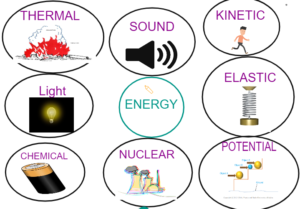
FORMS OF ENERGY
| ENERGY | DEFINATIONS | EXAMPLE |
| Thermal Energy | Energy from the heated objects. | Energy in Kettle |
| Light Energy | Energy that helps to see. | Bulb, Torch |
| Electrical Energy | Energy due to the flow of charge or current | Electrical Appliances |
| Chemical Energy | Energy stored in the chemical bonds | Food, Batteries |
| Sound Energy | Energy due to vibrations | Loudspeaker |
| Nuclear Energy | Energy stored in the nucleus of the atom | Nuclear Reactor |
| Kinetic Energy | Energy due to movement | Roller coaster moving down |
| Potential Energy | Energy due do the position | Ball raised to a height |
| Elastic Energy | Energy stored in stretch objects | Springs, Rubber |
Banner 3
ENERGY TRANSFER
Law of Conservation of Energy: Energy is neither created nor destroyed. It changes from one form to another.
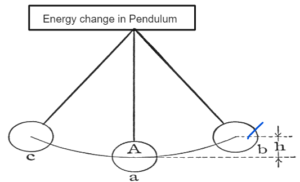
- At the extremes pendulum gains kinetic energy.
- As it comes back to mean position kinetic energy converts to gravitational potential energy.
- It goes to a height and gains potential energy.
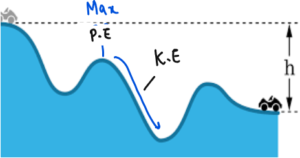
- The potential energy is converted into kinetic energy when it moves.
Banner 4
WORK AND ENERGY FORMULAE
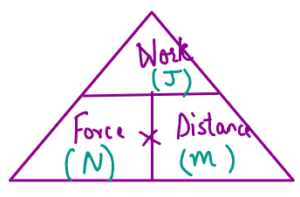
Potential Energy P.E = m x g x h
Potential energy in Joules (J) g is the gravitational field strength in N/kg, and h is the height in metres (m).
Kinetic Energy K.E = ½ mv2
m is the mass in kilograms(kg), v is the speed(m/s) and the kinetic energy in joules(J).
Elastic Potential Energy E.P.E. = ½ ke2
Elastic potential energy in joules (J), k is the spring constant in N/m and e is extension in metres (m).
Efficiency = useful output/ Total input x 100
Efficiency is the relationship between the useful work done by a machine, an engine, a device, etc. And the energy supplied to it, often expressed as a percentage.
- m: mass of the object
- g: Acceleration due to gravity
- v: velocity of an object
- k: spring constant
- e: extension
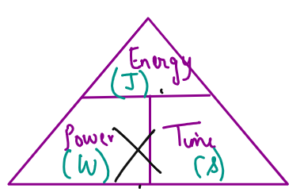
Banner 5
Examples
Q1 Calculate the work done when 2 N of force moves a block to a distance of 2 m
W =F x S = 2 x 2 = 4J
Q2 Calculate the kinetic energy when a 2kg block moves at the speed of 3 m/s
K.E = ½ mv2
½ x 2 x 32 = 9J
Q3 Calculate the potential energy when the mass of 2 Kg is raised to a height of 5m above the ground.
P.E = mgh
2 x 10 x 5 = 100J (g = 10m/s2)
Q4 Calculate the energy dissipated by a 10 W bulb in 2 minutes
E = P x t
= 10 x 2 x 60
= 1200J
HOOKE’s LAW
The extension produced in an elastic object is directly proportional to the force applied on it.
F ∝ e
F = ke
Elastic Potential Energy = ½ ke2
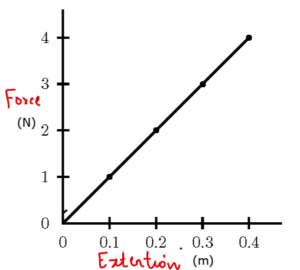
ENERGY EFFICIENCY
Energy efficiency, means using less energy to provide the same level of energy.
All appliances do not convert 100% of the input energy into useful energy.
The waste energy is dissipated to the surroundings.
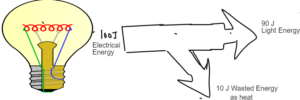
Energy efficiency = Useful/total x 100
= 90/100 x 100
= 90%
USEFUL AND WASTE ENERGY
| Device | Useful Energy | Waste Energy |
 | Light Energy | Heat Energy |
 | Kinetic Energy | Heat and Sound Energy |
 | Heat Energy | Light and Sound |
FRICTION
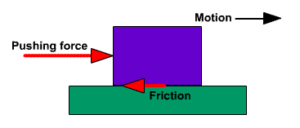
Friction is the force that opposes the motion of the body.
It results in loss of energy.
Methods to prevent friction:-
- a) Lubricate, paint or smooth the surface by regular oiling of the machines
- b) Streamline the body of the object like ship or plane to cut down air resistance
- c) Tighten the loose parts to prevent friction and reduce sound energy.
Banner 7
HEAT TRANSFER
CONDUCTION
- The process by which heat is transferred by the direct contact of the particles and the particles vibrate and conduct heat.
- Greater the transmission greater is the thermal conductivity of the material.
CONVECTION
- Heat transfer through fluids in which the hot molecules rises and the cold molecules sink generating a convection current.
RADIATION
- The process of heat transfer by electromagnetic radiation. There is not a direct contact between the two surfaces.
- The stove element heats the kettle and the kettle heats the water by conduction. Water circulating in the kettle transfers heat by convection. Near the stove, air would feel warm due to heat transfer by radiation.
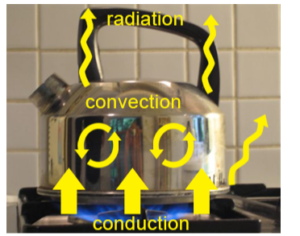
Banner 8
GREENHOUSE EFFECT
- It is the natural process that warms the surface of the Earth.
- When the Sun’s energy reaches the Earth’s atmosphere, part of it is reflected in space and the rest is absorbed and re-irradiated by greenhouse gases.
- Greenhouse gases include water vapor, carbon dioxide, methane, nitrous oxide, ozone and some artificial chemicals such as chlorofluorocarbons (CFCs).
- The energy absorbed warms the atmosphere and the surface of the Earth. This process keeps the Earth’s temperature at about 33 degrees Celsius warmer than it would be, allowing life on Earth to exist.
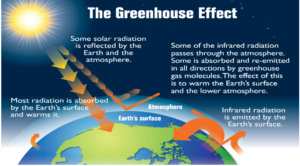
ENERGY LOSS IN HOMES
LOFT INSULATION
- Uses fibre glass in the loft.
- Fibre glass is an insulator and prevents the heat loss by conduction.
- Thicker the layer better the conduction.
CAVITY WALL INSULATION
- It is the insulation between the two layers of the bricks.
- The insulation between the bricks traps air and prevent loss of energy by conduction.
DOUBLE GLAZING
- Thicker glass with dry air or vaccum in between.
- Glass has lower conductivity and air act as an insulator prevent loss by conduction.
- The vaccum prevent loss by convection.
THICK BRICKS
- Thick bricks with lower thermal conductivity prevents the loss of heat by conduction.
FOILING
- Foiling between the radiator and the panel reflect the heat back into the home and prevent it from escaping.
SOURCES OF ENERGY
RENEWABLE
- The source of energy that can be replinished and will never run out.
- Eg – Solar, Wind, Geothermal
- Does not produce any harmful or greenhouse gases
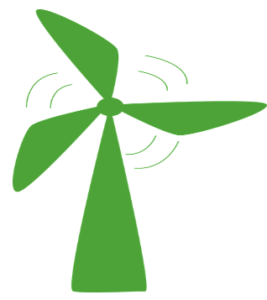
NON RENEWABLE
- The source of energy that cannot be replinished and will run out.
- Example: Fossil Fuels like coal, petrol, natural gas
- Produces harmful greenhouse gases.
BIOFUELS
- Making methane, ethanol or other fuel by using plant and animal waste which is :
- Biofuels convert the energy of the sun into plant materials, which are then processed to produce liquid fuels.
- Biofuels include ethanol, which can be replaced by gasoline in many recent model cars.
- For this reason, biofuels are particularly useful for meeting the energy needs of the transport sector.
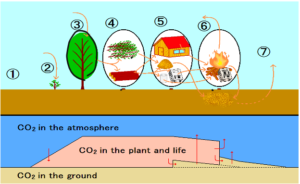
Banner 9
RENEWABLE SOURCE OF ENERGY
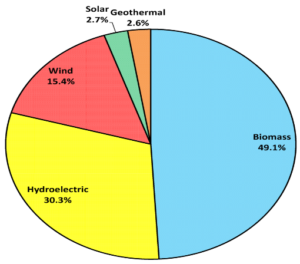
ENERGY ISSUES
Reliability
Cost
Demand – With the increase in global energy demand, common fossil fuels that produce energy, such as coal, oil and natural gas, are running out
Supply
KEY TERMS
- Kinetic energy: kinetic energy is the energy stored in something that moves.
- Gravitational Potential energy: the energy of gravity or the work done against gravity.
- Elastic Energy – Elastic energy is the potential energy stored as a result of the deformation of an elastic object, such as the stretching of a spring.
- Work Done – Work is done when a force moves something over a distance.
- Power – power is the rate of doing work or of transferring heat,
- Energy efficiency – means using less energy to provide the same level of energy.
- Useful Energy – Energy transferred in the form and where it is desired
- Waste Energy – The energy which is transferred to the surroundings is wasted.
- Friction – Friction is the force that opposes the motion of the body.
- Conduction – The process by which heat is transferred by the direct contact of the particles and the particles vibrate and conduct heat.
- Convection – Heat transfer through fluids in which the hot molecules rises and the cold molecules sink generating a convection current.
- Radiation – The process of heat transfer by electromagnetic radiation. There is not a direct contact between the two surfaces.
- Greenhouse Effect – It is the natural process that warms the surface of the Earth.
- Renewable Energy – The source of energy that can be replinished and will never run out.
- Non renewable Energy – The source of energy that cannot be replinished and will run out.
- Biofuel – Biofuels convert the energy of the sun into plant materials, which are then processed to produce liquid fuels.
- Tidal Energy – It is a form of hydropower that converts the energy obtained from tides into useful forms of power, mainly electricity.
- Solar Energy – Radiation from the Sun capable of producing heat, generating electricity.
Banner 10
Disclaimer:
I have tried my level best to cover the maximum of your specification. But this is not the alternative to the textbook. You should cover the specification or the textbook thoroughly. This is the quick revision to help you cover the gist of everything. In case you spot any errors then do let us know and we will rectify it.
References:
BBC Bitesize
Wikipedia
Wikimedia Commons
Image Source:
Wikipedia
Wikimedia
Commons
Flickr
Pixabay
Make sure you have watched the above videos and are familiar with the key definations before trying these questions. It is also good to time yourself while doing these questions so that you can work on the speed as well.
P3-Energy Resources
